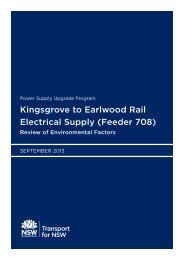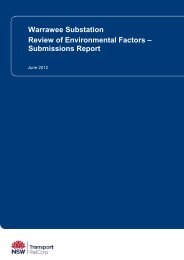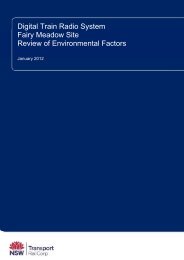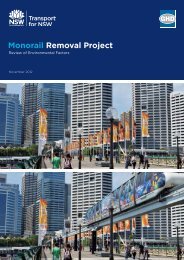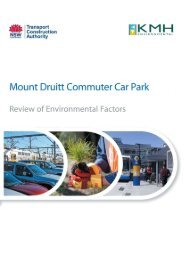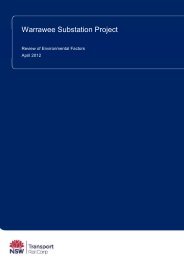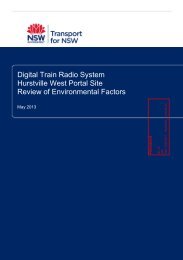Review of Environmental Factors - Transport for NSW - NSW ...
Review of Environmental Factors - Transport for NSW - NSW ...
Review of Environmental Factors - Transport for NSW - NSW ...
You also want an ePaper? Increase the reach of your titles
YUMPU automatically turns print PDFs into web optimized ePapers that Google loves.
3.3 Timing and CostingConstruction is planned to begin in the first half <strong>of</strong> 2012 and construction activities will requirefour to six weeks. The bulk <strong>of</strong> work may require to be undertaken in non-consecutive work days.Proposed construction timing:Standard working hoursMonday to Friday 7.00am to 6.00pmSaturday 8:00am to 1:00pmEvening/weekends/out <strong>of</strong> hours:Work may be undertaken during scheduledpossessionsThe DTRS project has an overarching value <strong>of</strong> $225 million. This includes the design, supply,and installation <strong>of</strong> the DTRS on RailCorp’s electrified network plus a five-year life supportcomponent.3.4 Alternatives to the DTRSAs discussed earlier, the Waterfall Special Commission <strong>of</strong> Inquiry precipitated therecommendations regarding communications in <strong>NSW</strong> rail operations and within RailCorp. The<strong>NSW</strong> Government then committed to a state-wide strategy <strong>for</strong> all rail communications.RailCorp investigated a number <strong>of</strong> alternatives already used by the state government oravailable commercially, looking <strong>for</strong> a system that met its own safety and reliability requirementsas well as the recommendations <strong>of</strong> the Waterfall inquiry.The government alternatives were the existing MetroNet system or the Government RadioNetwork (GRN).The existing MetroNet communication system was not deemed a feasible solution <strong>for</strong> thereasons listed below.• It uses outdated technology and cannot be expanded due to its limited capacity.• It does not have the ability to support the requirements <strong>of</strong> Automatic Train Protection.• It only has one main supplier and this, combined with obsolete technology, means the cost<strong>of</strong> using and maintaining the MetroNet system is increasing at a substantial rate.• It cannot facilitate a communications plat<strong>for</strong>m that can be used by all necessary RailCorppersonnel.• It could not meet interoperability requirements.The Department <strong>of</strong> Commerce’s Government Radio Network (GRN) was not deemed a feasiblesolution <strong>for</strong> the reasons listed below.• It has to be shared with other <strong>NSW</strong> Government agencies.• Priority is given to emergency services which could result in a failure <strong>of</strong> 100% rail networkcoverage.Page 25 <strong>of</strong> 64



